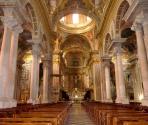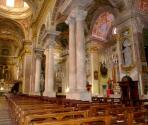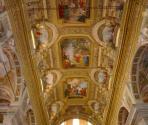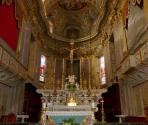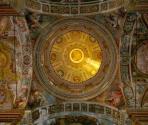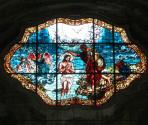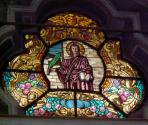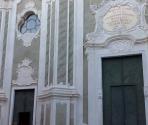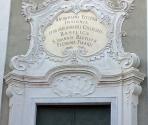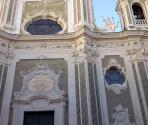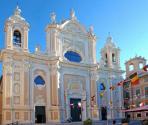Basilica (Collegiate Church) of Saint John the Baptist

The construction of the basilica started in 1619 and lasted 55 years. The Temple was inaugurated in 1674. It is one of the most beautiful churches in Liguria, traditionally ascribed to Bernini, but probably planned by local architects of his school. The façade, rich in artistic emblems and stained-glass windows, is the work of Finalmarina architect Nicola Barella. It was completed in 1762. The statues of St. John the Baptist, of Saints Peter and Paul and those symbolizing Hope and Faith with their beautiful decorations are the work of Bartolomeo Bagutti.
The statue of S. John on the façade and those symbolizing the Virtues on the inside, are the work of Savonese Antonio Brilla. The dome, 24 metres high, was designed by Barella with the collaboration of architects Cantone and Tagliafico from Genoa. An artistic baptistery stands near the main entrance. The interior, where the baroque style is tempered by a lively classical tradition, is characterized by a great harmony and simplicity of proportions. The central nave is separated from the two aisles by two rows of paired columns. It was decorated by painter Giuseppe Passano with episodes from Saint John’s life among groups of angels. Twelve very rich chapels are situated in the two aisles and were decorated with architectural motifs by painter Giacomo Picco. The high altar, built in 1767, is inlaid with polychrome marbles. The tribunes or choirs on the sides of the presbytery were completed in 1806. The pulpit is the work of Pietro Ripa. The organ, the work of Casa Bernasconi of Varese, was placed above the choir in corpu epistulae in 1904, on the occasion of the celebrations for the fiftieth anniversary of the proclamation of the dogma of the Immaculate Conception. The Tabernacle is decorated with angels, flowers and raised ornaments, the vault was decorated by Savonese Gerolamo Brusco in 1807-1808 with colourful frescoes representing the Baptism of Christ, St. John the Baptist preaching on the bank of river Jordan and the Glory of St. John. G. Brusco also painted the central window of the apse and the three big paintings above the entrances. The most remarkable among the twelve chapels are those dedicated to Saint Anne (once of St. Ermo, with frescoes by G. B. Merano dated 1693 and by Domenico Bocciardo dated 1834 and statues by Giuseppe Chiappori); the Chapel of the Immaculate Conception (sumptuous and admirable, with wonderful polychrome marble compositions, frescoes by G. B. Merano, statues by G. B. Villa and precious relics) and the chapels of St. Peter, St. Teresina, St. Andrew, St. Joseph and the Guardian Angel, the Crucifix and St. Anthony. The apse with its wonderful choir was built in 1671. The ancient choir was replaced in 1727 with 48 carved walnut stalls. The Baptistery, on the left, is a magnificent work of art. “Over a white marble urn, inlaid with the finest agate, stands a statue of classic beauty representing St. John the Baptist”, the work of Salvatore Revelli, created in 1853. A painting portaying St. Ermo and St. Nicholas, recently restored, is preserved in the sacristy together with other 17th and 18th century’s paintings. In its lower part it presents an interesting view of Finale in the 17th century.
The statue of S. John on the façade and those symbolizing the Virtues on the inside, are the work of Savonese Antonio Brilla. The dome, 24 metres high, was designed by Barella with the collaboration of architects Cantone and Tagliafico from Genoa. An artistic baptistery stands near the main entrance. The interior, where the baroque style is tempered by a lively classical tradition, is characterized by a great harmony and simplicity of proportions. The central nave is separated from the two aisles by two rows of paired columns. It was decorated by painter Giuseppe Passano with episodes from Saint John’s life among groups of angels. Twelve very rich chapels are situated in the two aisles and were decorated with architectural motifs by painter Giacomo Picco. The high altar, built in 1767, is inlaid with polychrome marbles. The tribunes or choirs on the sides of the presbytery were completed in 1806. The pulpit is the work of Pietro Ripa. The organ, the work of Casa Bernasconi of Varese, was placed above the choir in corpu epistulae in 1904, on the occasion of the celebrations for the fiftieth anniversary of the proclamation of the dogma of the Immaculate Conception. The Tabernacle is decorated with angels, flowers and raised ornaments, the vault was decorated by Savonese Gerolamo Brusco in 1807-1808 with colourful frescoes representing the Baptism of Christ, St. John the Baptist preaching on the bank of river Jordan and the Glory of St. John. G. Brusco also painted the central window of the apse and the three big paintings above the entrances. The most remarkable among the twelve chapels are those dedicated to Saint Anne (once of St. Ermo, with frescoes by G. B. Merano dated 1693 and by Domenico Bocciardo dated 1834 and statues by Giuseppe Chiappori); the Chapel of the Immaculate Conception (sumptuous and admirable, with wonderful polychrome marble compositions, frescoes by G. B. Merano, statues by G. B. Villa and precious relics) and the chapels of St. Peter, St. Teresina, St. Andrew, St. Joseph and the Guardian Angel, the Crucifix and St. Anthony. The apse with its wonderful choir was built in 1671. The ancient choir was replaced in 1727 with 48 carved walnut stalls. The Baptistery, on the left, is a magnificent work of art. “Over a white marble urn, inlaid with the finest agate, stands a statue of classic beauty representing St. John the Baptist”, the work of Salvatore Revelli, created in 1853. A painting portaying St. Ermo and St. Nicholas, recently restored, is preserved in the sacristy together with other 17th and 18th century’s paintings. In its lower part it presents an interesting view of Finale in the 17th century.
See also:

